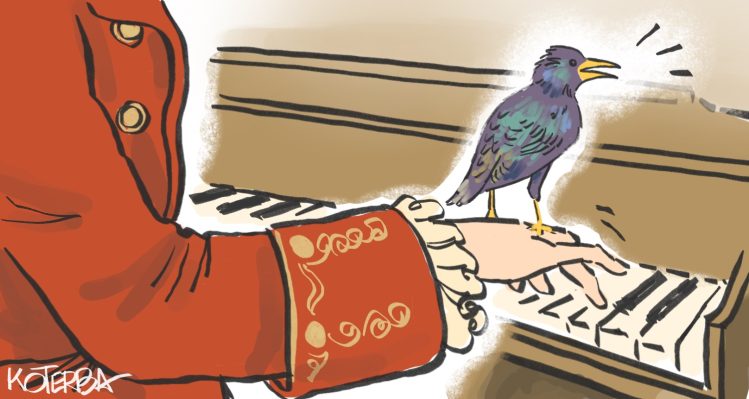
Mozart: A Little Bird Told Him
October 29th, 2023
While I was growing up, I had a parakeet, a cat, several dogs, and yes, for a while, a pet goat (it was a 4-H project that got out of hand). I don’t remember believing that any of my fur babies functioned at the intellectual level of a human being. None of my dogs composed a concerto, or played a piano. And as much as I love my current four-pound teacup Chihuahua, I’m certain she’s not a musical genius.
But enter the pets of Wolfgang Amadeus Mozart. Mozart, of course, was a genius who had a couple of dogs, and a few canaries. But Mozart also had a pet that just might have been smarter than his dogs, and maybe some people I know. Mozart’s most famous pet was a starling. Not just any bird, but a fowl who might have invented, or at least inspired a five-note theme in the last movement of Mozart’s 17th Piano Concerto. I say “may,” because the question is, which came first, the bird or the tune?
There are some historians who conjectured that Mozart bought the bird because he liked what he heard the bird singing. The same year that he wrote his 17th Piano Concerto, the composer jotted down a musical theme in his expense book, right next to the price he paid for the starling. This musical notation is very close to the opening theme of the final movement of his Piano Concerto No. 17. Did Mozart hear the bird singing this great theme, then buy the creature to possess it? Or did he compose the theme of it himself, then teach the bird to sing it?
A notation in Mozart’s expense book was made on May 27, 1784, that the composer bought a pet starling able to whistle the notes written in the margin. Those notes matched the first five measures of the finale of Mozart’s 17th Piano Concerto.
Well, it seems that Mozart entered the 17th piano concerto in his music catalog on April 12, 1784, about a month before buying his pet starling. So, other historians insist that Mozart taught the tune to the starling and not the other way around.
Even if that is the case, that smart little fowl could whistle the first five measures of a Mozart composition. Mozart’s pet starling, as one musical historian suggests, was a “virtuoso mimic,“ (obviously smarter than my dog, who can’t carry a tune). And Mozart also noted in his journal that he and his starling were in agreement over the seventeen-note theme for this concerto finale. But the composer also complained that the bird always sang one note sharp and held another too long. Nobody’s perfect.
There’s no question it was one smart starling! Smart enough to be capable of whistling part of Mozart’s Piano Concerto No. 17 in G Major. Can your dog or cat do that? I think not.
A postscript about the starling: the bird lived with Mozart’s family for three years, before dying on June 4, 1787. Mozart held a funeral for his feathered friend, with considerable ceremony, including a funeral procession of heavily veiled friends in proper mourning attire. The bird was laid to rest in the garden with a Mozart written elegy inscribed on its gravestone that begins, “A little fool lies here / Whom I held dear…”
The Concerto No. 17 lives on—one of only six of Mozart’s piano concertos that were published during his lifetime. It’s one of his finest. A little bird told me.
Here’s Lang Lang performing the third movement from that concerto: https://www.youtube.com/watch?v=5PMd__nRhqY

